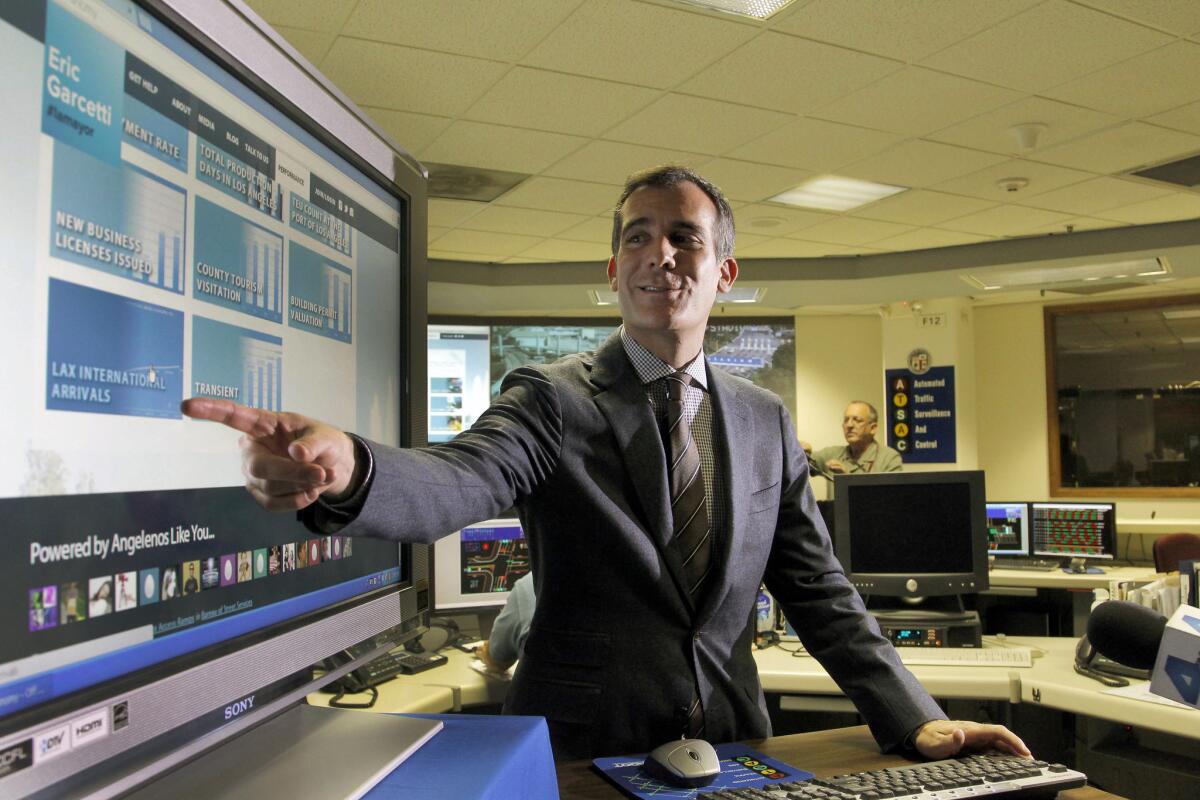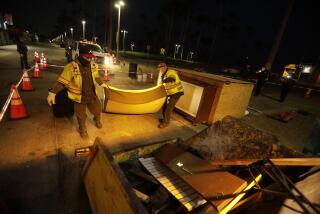Can data build a better L.A.?

Last week, Los Angeles Mayor Eric Garcetti unveiled the first specifics of his plan to modernize the city’s sprawling bureaucracy, posting on his website some of the metrics by which he intends to hold city departments accountable for delivering services. They include such measurements as Fire Department response times and speed of graffiti removal and pothole repair.
The mayor’s attempt to improve performance is certainly timely. A recent USC Price/L.A. Times poll found that Angelenos want better services. For example, more than 60% of respondents were dissatisfied with the state of street repair in the city. But metrics and data collection alone won’t solve the city’s problems. Garcetti will also need to transform the culture of city government and convince city workers that the changes will stick.
Data can certainly be an important part of that process. When heading the New York and L.A. police departments, William J. Bratton pioneered CompStat, a system that deployed police resources based on real-time crime data, and achieved dramatic reductions in crime rates. New York Mayor Michael Bloomberg used a performance-based system to double the percentage of city parks rated clean and safe. And as mayor of Baltimore, Martin O’Malley saved more than $13 million in the first year he employed CitiStat, a system modeled on CompStat, to monitor employee absenteeism and overtime. The program was later expanded to assist in managing all departments.
But simply collecting more data can’t guarantee results. Consider the experience of former Gov. Arnold Schwarzenegger, who vowed to reorganize state government in his first State of the State address, asserting that “I don’t want to move boxes around; I want to blow them up.” The result was the California Performance Review, which employed performance metrics and strategic planning to produce hundreds of recommendations for improved government efficiency.
In the end, though, implementation foundered as resistance sprang up on multiple fronts. The Democratic-controlled Legislature balked at changes to social programs, senior agency managers resisted ceding control of their fiefdoms and public-sector unions balked at possible job cuts.
So what can Garcetti do to give his plans a chance of succeeding? In addition to gathering numbers, he needs to focus on qualitative issues. One statistic on the mayor’s website involves bike lanes, for example, and it looks great. Last year, the total miles of bike lanes in the city increased by 35%. But there is little to indicate what the effect of the new lanes has been. Are they being used? Do riders like them? And are other important metrics — such as density of development and number of bicycle-involved accidents — being considered in deciding where new lanes should be placed?
Garcetti and his key deputies must drive the data analysis and demonstrate to city departments their commitment to evidence-based problem-solving. City managers need to know they’ll be rewarded for coming up with effective solutions but won’t be punished when the data reveal problems. One point of collecting data is to find problem areas that need attention.
Garcetti also needs to ensure that the data he’s collecting are reliable. Fire response times mean nothing, for example, if they’re not being accurately reported. And the data need to be analyzed effectively. If CompStat had simply looked at citywide crime-rate statistics, nothing would have changed. The data needed to be broken down to reveal what types of crime were occurring at the neighborhood level and analyzed over time to identify increases in specific areas. The Bureau of Street Services, which rates the condition of every city street and publishes neighborhood street-quality maps, and the Police Department are already using data effectively. These examples need to be replicated in other departments.
Innovative means of collecting data should also be considered. Boston, for example, has pioneered a mobile phone app, Street Bump, that records bumps caused by potholes as users drive through the city. And as we have learned from Amazon and Netflix, every service interaction is an opportunity to solicit feedback on how the city is performing. The California DMV conducts more than 100,000 short surveys a year, providing a gold mine of consumer satisfaction data.
Garcetti needs some early successes to improve the long-term prospects of his reform efforts. One reason Schwarzenegger’s performance review didn’t achieve the kind of fundamental change he envisioned was that it raised all the issues at once, which meant that simple recommendations were lumped in with highly controversial ones. To avoid that swamp, the mayor should focus initially on easily measured and improved city services, such as cutting overtime pay.
Improving the delivery of city services won’t be easy. But Los Angeles will benefit greatly if Garcetti can keep his ardor for measuring performance and use it to make lasting improvements.
Christopher Weare is a research associate professor and Juliet Ann Musso is an associate professor at USC’s Price School of Public Policy
More to Read
A cure for the common opinion
Get thought-provoking perspectives with our weekly newsletter.
You may occasionally receive promotional content from the Los Angeles Times.






